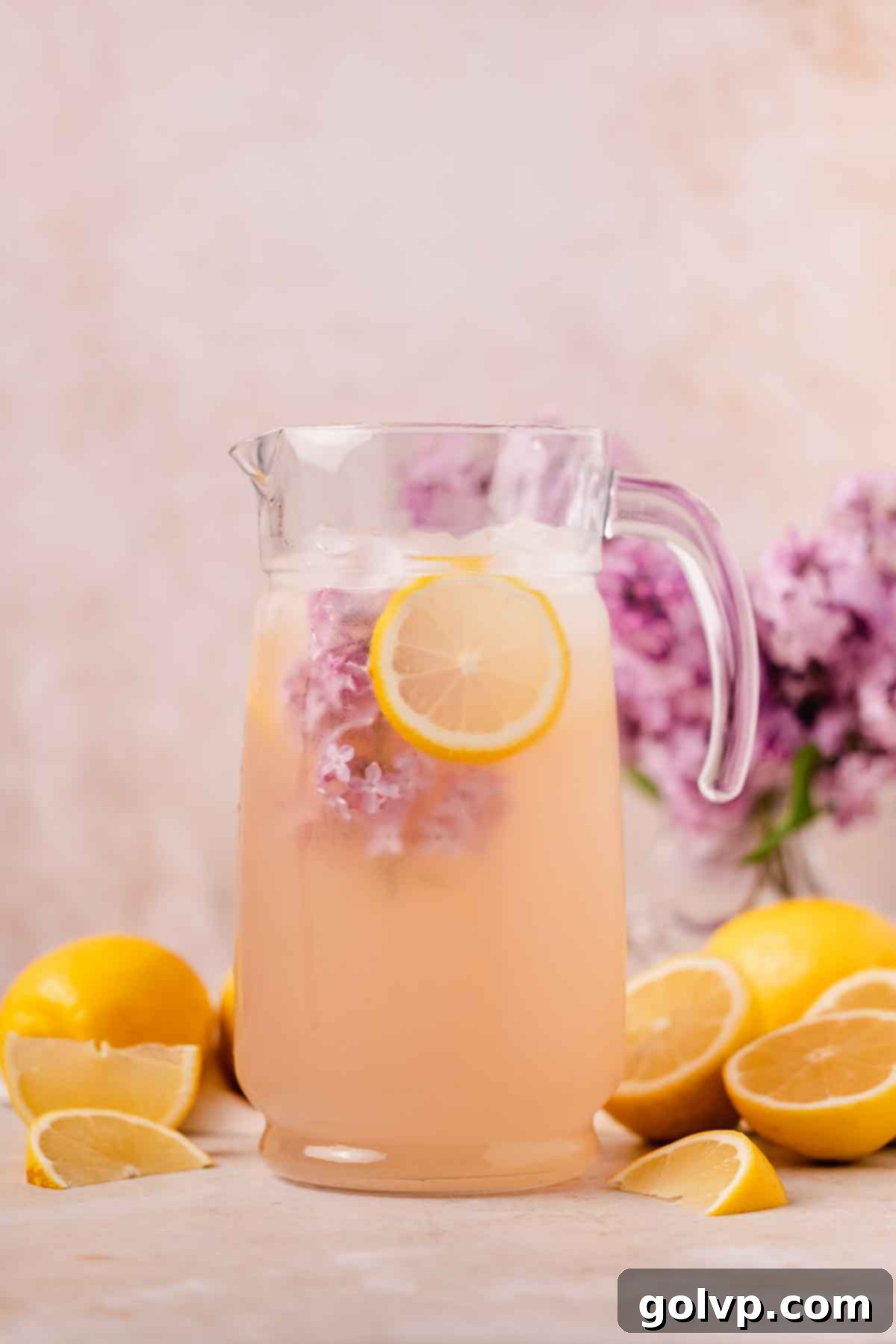Homemade Color Changing Lilac Lemonade: A Refreshing and Whimsical Spring Drink Recipe
Discover the magic of spring with this enchanting Color Changing Lilac Lemonade! This delightful beverage is more than just a drink; it’s an experience. Combining the vibrant tang of fresh lemons with the delicate, sweet fragrance of lilac blossoms, it creates a truly unique and refreshing taste sensation. The real showstopper, however, is its incredible ability to transform colors right before your eyes, making it an instant favorite for kids and adults alike. Easy to prepare using a homemade lilac-infused simple syrup, this lemonade captures the essence of spring in every sip. Imagine serving this whimsical, fragrant concoction at your next backyard gathering – it’s sure to be the talk of the party!
Making your own lilac lemonade at home is surprisingly simple, and the reward is immense. You’ll be crafting a beverage that not only tastes extraordinary but also offers a beautiful visual spectacle. The subtle floral notes from the lilacs add a layer of sophistication and freshness that elevates classic lemonade to an entirely new level. This recipe is designed to be straightforward, ensuring that even novice home mixologists can achieve perfect results. Get ready to impress your guests and treat your senses to this vibrant, homemade delight!
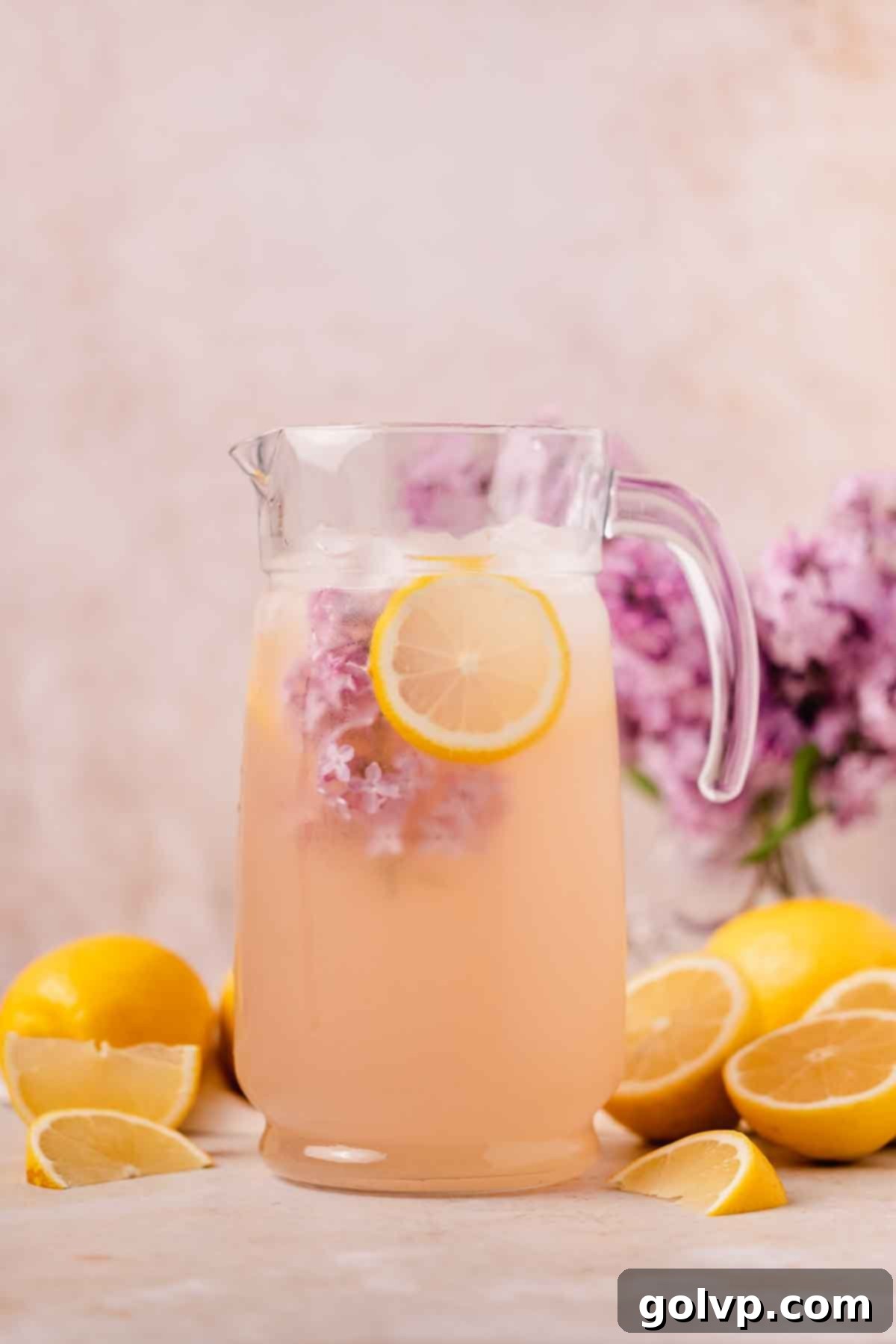
🌼 Why You’ll LOVE This Unique Lilac Lemonade Recipe
- Exquisite Lilac Flavor: Unlike anything store-bought, this recipe features an intensely fragrant, homemade lilac simple syrup. It infuses the lemonade with truly delicate, sweet, and aromatic floral notes that perfectly complement the lemon. The fresh lilac essence is captivating and wonderfully unique.
- Perfectly Balanced Lemonade: This isn’t just a floral drink; it’s a robust lemonade base, bursting with tart, sweet, and incredibly refreshing lemon flavor. The balance between the zingy lemon and the gentle lilac creates a harmonious and addictive beverage, ideal for warmer weather and celebrating the beauty of lilac season.
- Effortless Preparation: Don’t let its sophisticated flavor fool you – this lemonade is remarkably easy to make. The lilac syrup, the heart of the drink, can even be prepared 1-2 weeks in advance, allowing for quick assembly when you’re ready to serve. This makes it a fantastic option for entertaining or for simply enjoying a special treat without much fuss.
- Magical Color Change: One of the most captivating aspects of this lilac lemonade is its magical color transformation. As the lilac syrup, rich in natural anthocyanin pigments, mixes with the acidic lemon juice, it shifts from a purple hue to a beautiful peach or reddish-pink color. This natural phenomenon is not only fascinating for children but adds an element of whimsical charm to any occasion.
- Visually Stunning: Beyond the color change, the lemonade itself is a visual treat. Served with fresh lemon slices and a sprig of lilac blossoms, it creates an elegant and inviting presentation that enhances any table setting or party decor.
If you’re eager to continue exploring the delightful flavors of lilac, consider pairing this refreshing lemonade with a complementary dessert. My lilac cake recipe offers a perfect balance of floral and citrus, echoing the notes in this drink. Alternatively, these lemon poppy seed scones make for a lovely, light accompaniment.

📝 Essential Ingredients for Lilac Lemonade
To achieve the best flavor and the captivating color change, attention to your ingredients is key. Read through for all the tips you will need for success!
Full steps and ingredients can be found in the recipe card below.
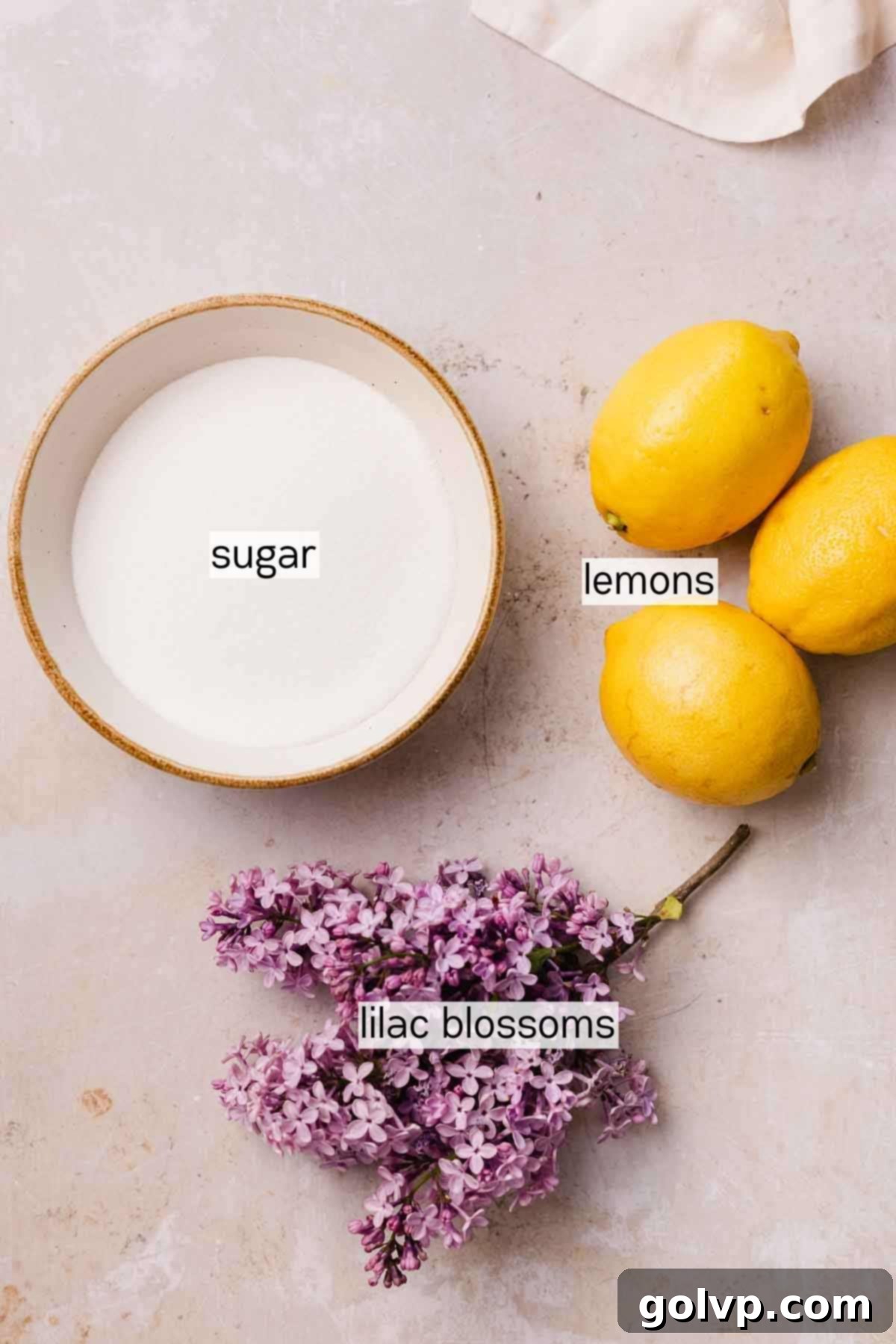
- Lilac Blossoms: The star of the show! You will need approximately 2 cups of fresh lilac blossoms, packed. For the most potent and fragrant syrup, choose branches with blossoms that are fully opened but haven’t started to wilt or fall off. Early morning is often the best time to pick them when their fragrance is strongest. Ensure they are free from pesticides or any chemical treatments.
- Lemons: Freshly squeezed lemon juice is paramount for truly delicious lemonade. You’ll need about 3 large lemons, yielding roughly ¾ cup of juice. Avoid using bottled or pre-squeezed lemon juice; it simply won’t deliver the bright, zesty, and refreshing flavor that fresh lemons provide. The acidity of fresh lemons is also crucial for the color-changing effect.
- Granulated Sugar: Essential for both the simple syrup and to balance the tartness of the lemon. White granulated sugar works best for a clear syrup that showcases the lilac’s natural color.
- Water: Used for making the simple syrup and diluting the lemonade to your desired strength.
- Ice: Crucial for serving a perfectly chilled and refreshing glass of lilac lemonade.
In addition to these key ingredients, you will, of course, need plenty of fresh water and ice to complete your refreshing beverage. Remember that the quality of your ingredients directly impacts the final taste and appearance of your lilac lemonade, so opt for the freshest possible options.
✔️ Ingredient Substitutions & Variations
While fresh lilacs offer a truly unique flavor, if you find yourself unable to source them, there are still ways to enjoy a floral-infused lemonade:
Elderflower: The most recommended substitute for lilacs is elderflower. They share a delicate, sweet, and subtly floral flavor profile that is wonderfully complementary to lemon. You can easily find commercially available elderflower syrup (like St-Germain) in many stores, making it a convenient option. Simply use store-bought elderflower syrup in place of the homemade lilac syrup. Adjust the amount to taste, as commercial syrups can vary in sweetness and concentration.
Lavender: For a different, more pronounced floral note, lavender syrup can also be used. Be mindful that lavender has a stronger, sometimes “soapy” flavor to some palates, so use it sparingly and taste as you go. Homemade lavender syrup is also an option if you have access to edible lavender flowers.
Rose Water/Syrup: A few drops of rose water or a splash of rose syrup can also impart a lovely floral aroma, though it will have a distinct flavor different from lilacs. This works well if you enjoy the romantic, sweet notes of rose.
When using any pre-made floral syrup, remember to adjust the amount of sugar in your lemonade base if necessary, as these syrups are often quite sweet on their own. The goal is always a balanced, refreshing drink.
👩🍳 Step-by-Step Guide: Crafting Your Lilac Lemonade
Making this beautiful color-changing lilac lemonade is a two-part process: first, creating the fragrant lilac syrup, and then assembling the lemonade itself. Follow these simple steps for a perfect result every time.
Homemade Lilac Syrup Step-by-Step
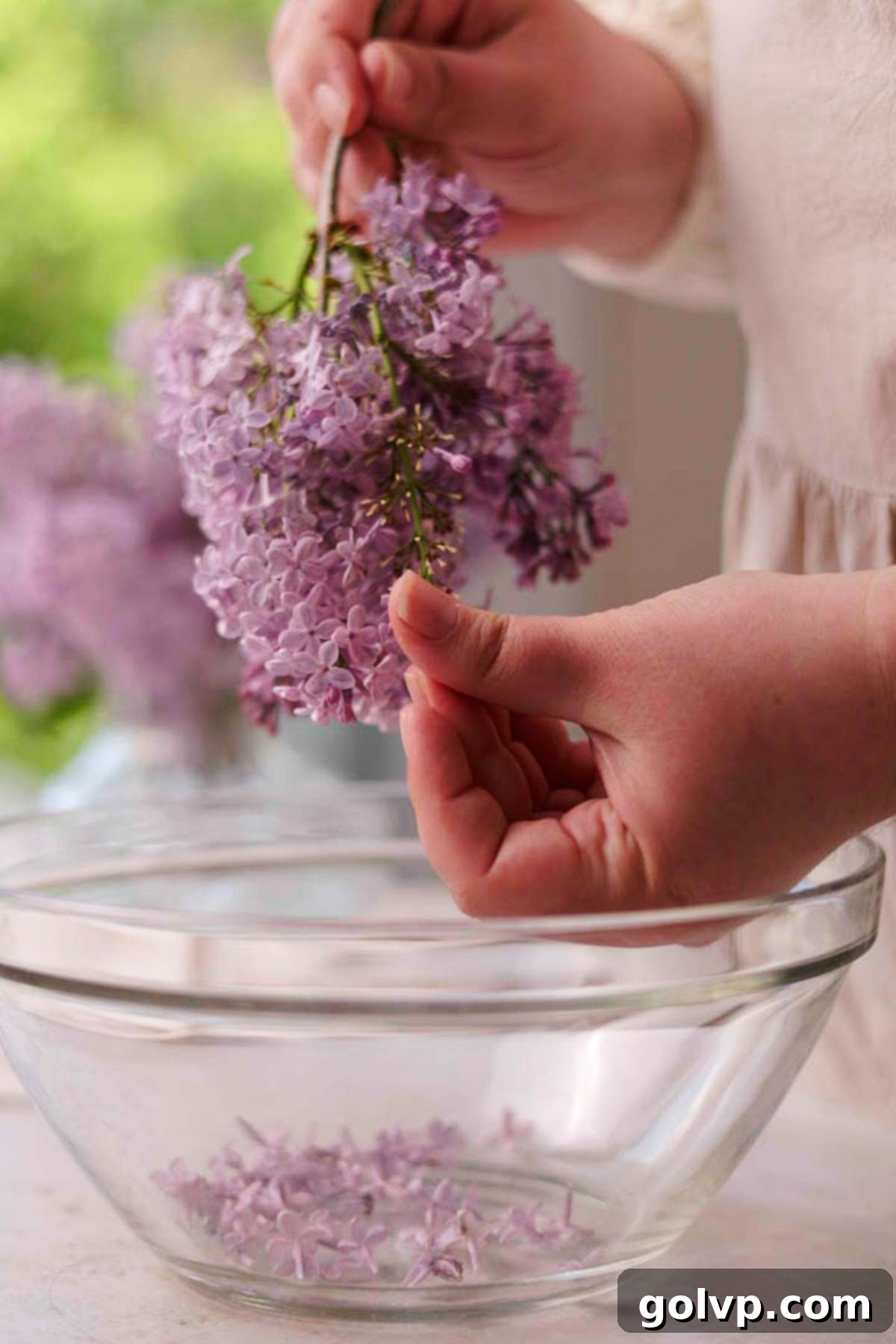
Step 1: Prepare the Lilac Blossoms. Carefully pluck the individual lilac flowers off their green stems and into a clean bowl. The green parts can sometimes impart a bitter taste, so focus on just the delicate petals. Once collected, add enough cold water to cover the blossoms completely. Let them sit for about 10 minutes, then gently rinse them thoroughly to remove any hidden dirt, dust, or tiny insects. This step is crucial for both cleanliness and flavor. Drain the water well after rinsing. Finally, measure out 2 cups of the clean lilac blossoms, packed firmly into the measuring cup. Don’t worry if you have slightly more or less; the recipe is forgiving.
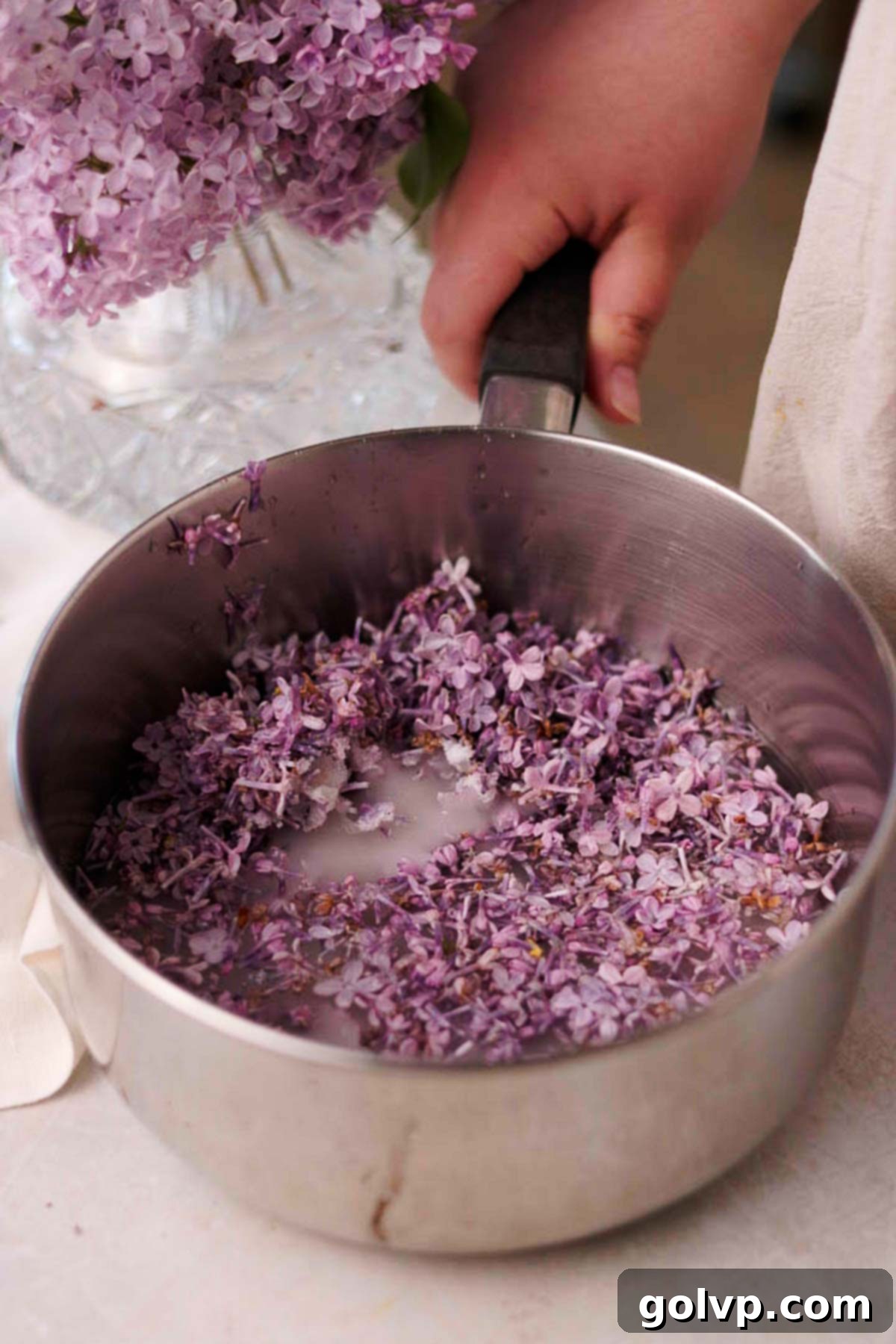
Step 2: Create the Simple Syrup Base. Transfer the cleaned and measured lilac flowers into a medium-sized saucepan. Add the granulated sugar and 1 cup of fresh water to the saucepan. Ensure all ingredients are combined before heating. This mixture will become the aromatic base for your lemonade.
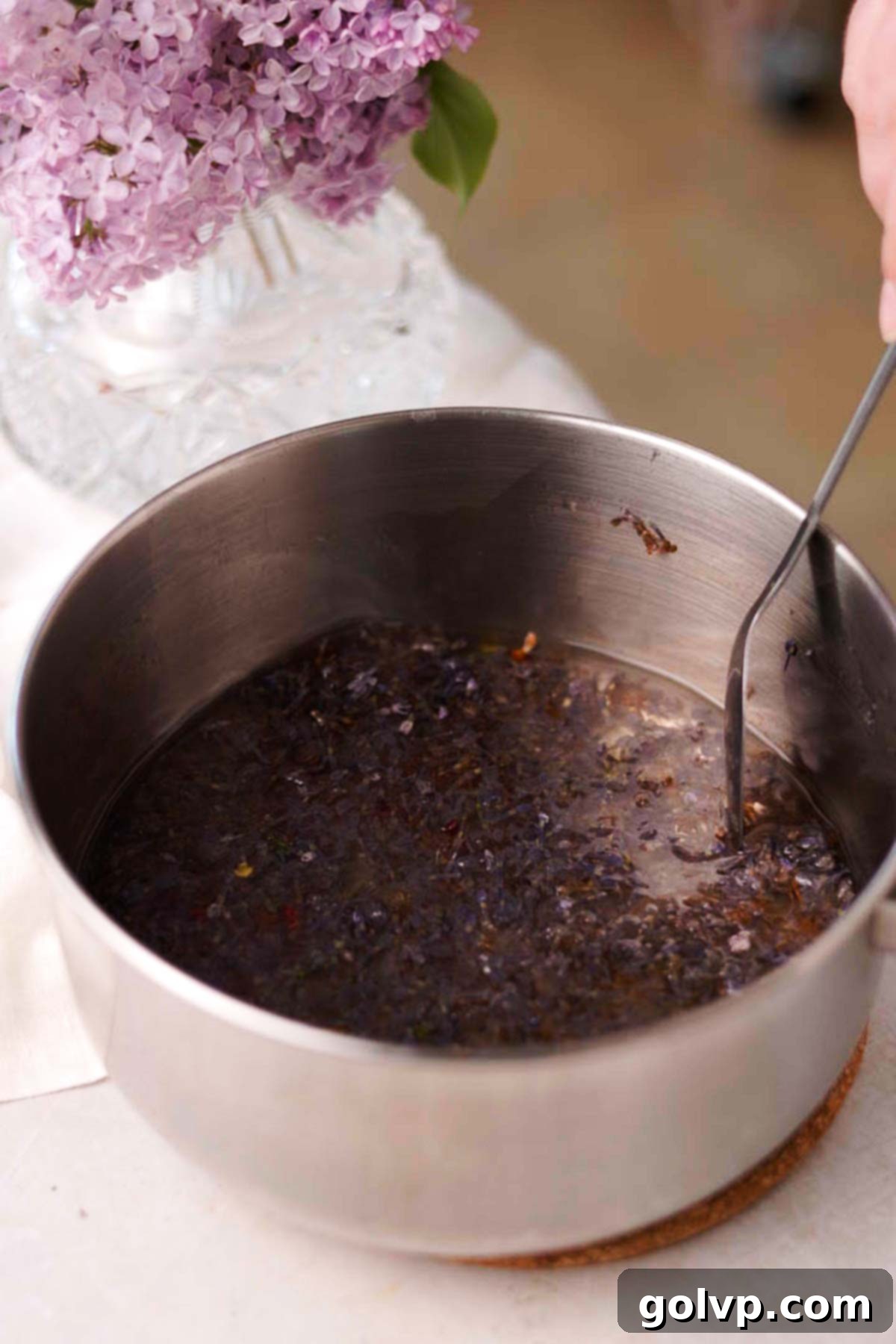
Step 3: Simmer and Infuse. Bring the mixture in the saucepan to a gentle boil over medium heat, stirring occasionally to ensure the sugar fully dissolves. Once boiling, reduce the heat slightly and let it simmer for just 1 minute. This brief simmering helps extract the delicate flavors and colors from the lilac blossoms. Immediately turn off the heat and allow the syrup to cool completely to room temperature right in the saucepan. This slow cooling process allows the lilacs to further infuse their fragrance and color into the syrup, intensifying the final product.
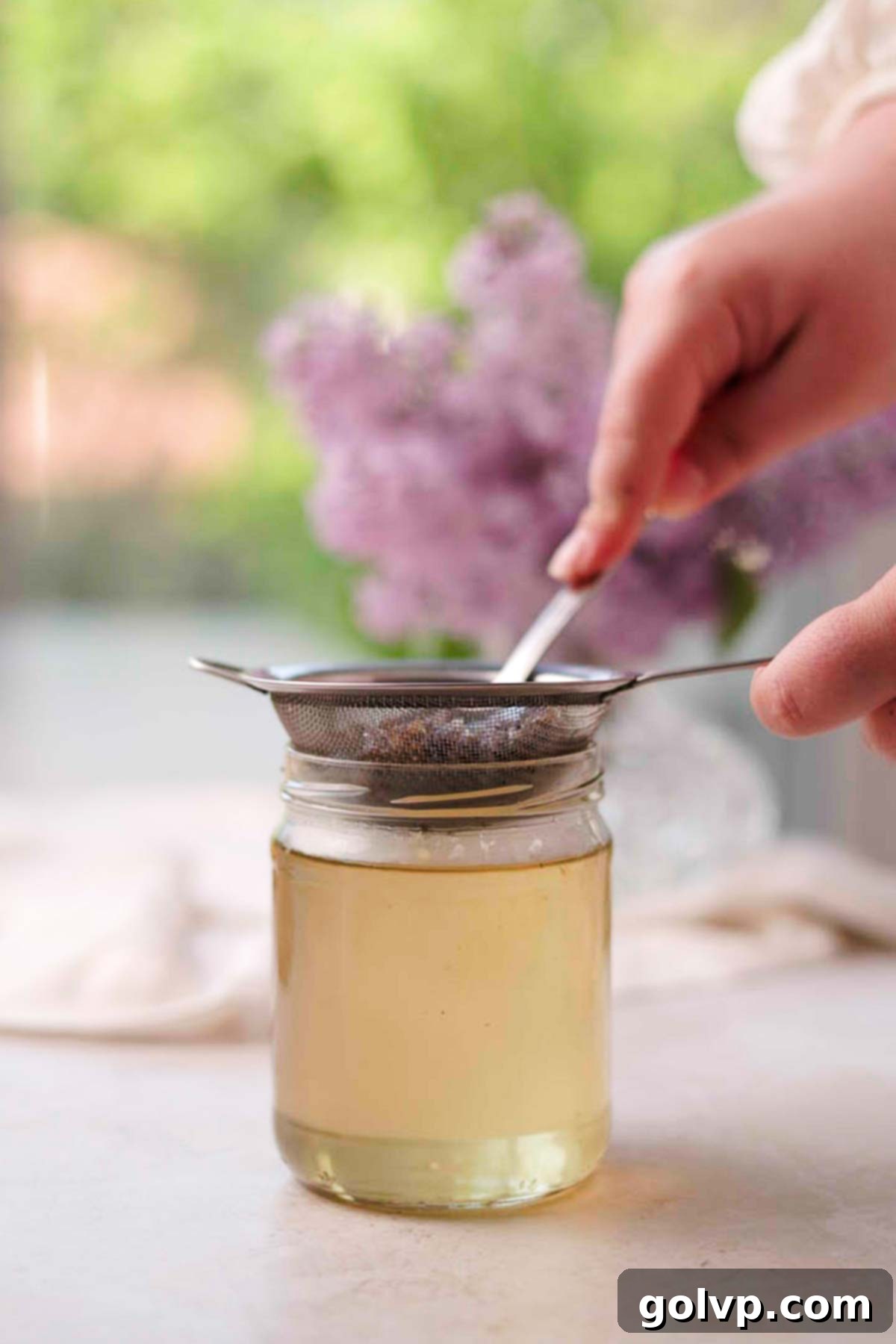
Step 4: Strain and Store the Syrup. Once the lilac syrup has fully cooled, strain it into a clean glass jar or airtight container using a fine-mesh sieve. Gently press on the lilac petals with the back of a spoon to extract every last drop of the fragrant syrup. Discard the spent lilac flowers. Your homemade lilac syrup is now ready to use or store in the refrigerator for up to 1-2 weeks.
Lemonade Assembly Step-by-Step
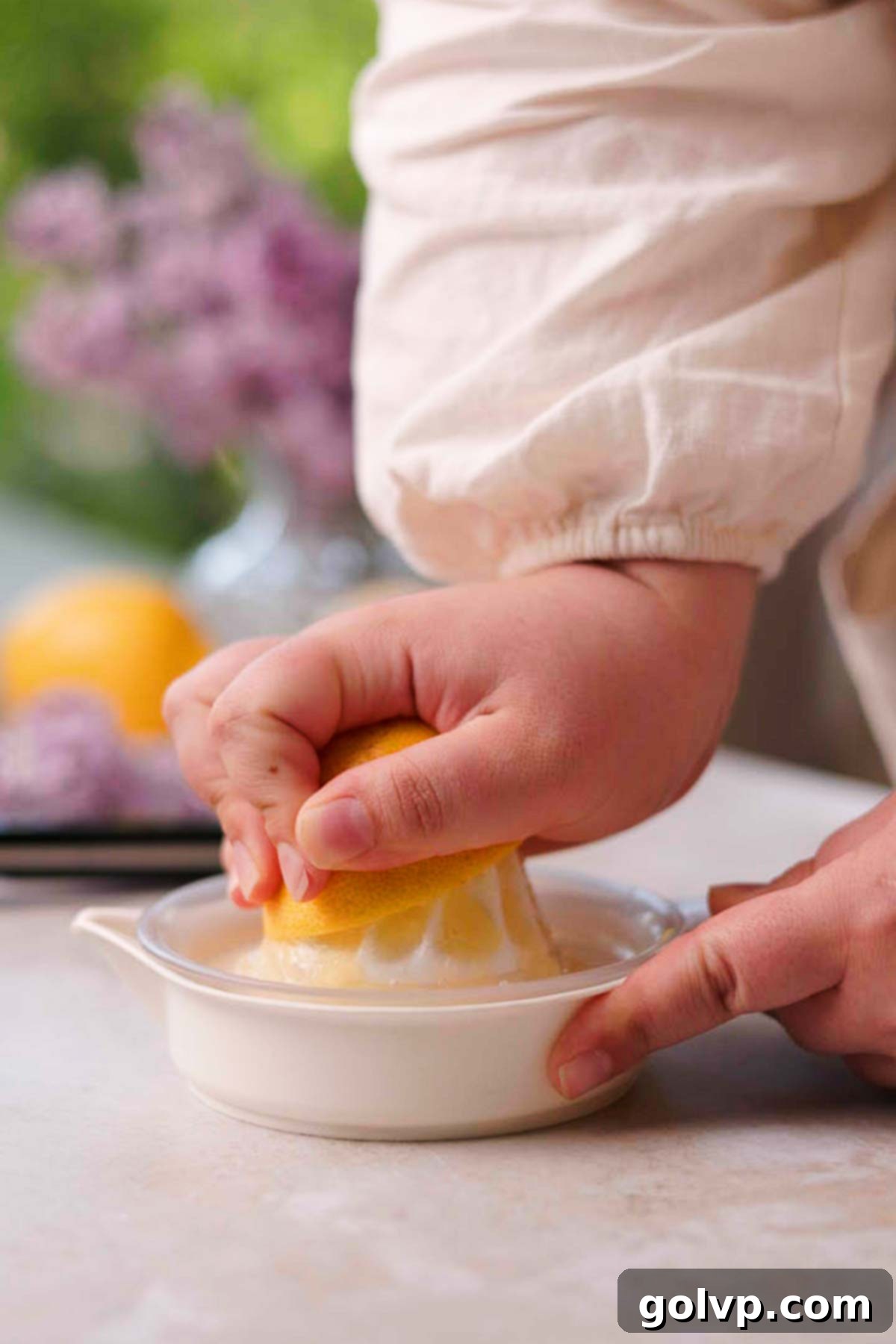
Step 1: Juice the Lemons. Thoroughly squeeze the fresh lemons to extract all their juice. Pour the freshly squeezed lemon juice into a large non-metal pitcher. It’s crucial to avoid using metal pitchers or containers for lemonade and other acidic beverages, as the acid can react with the metal, leading to an unpleasant metallic aftertaste that can spoil the delicate flavors of your drink. Opt for a glass, ceramic, or high-quality plastic pitcher instead.
Pro Tip: To get the most juice from your lemons, roll them firmly on your countertop for a few seconds before cutting and squeezing.
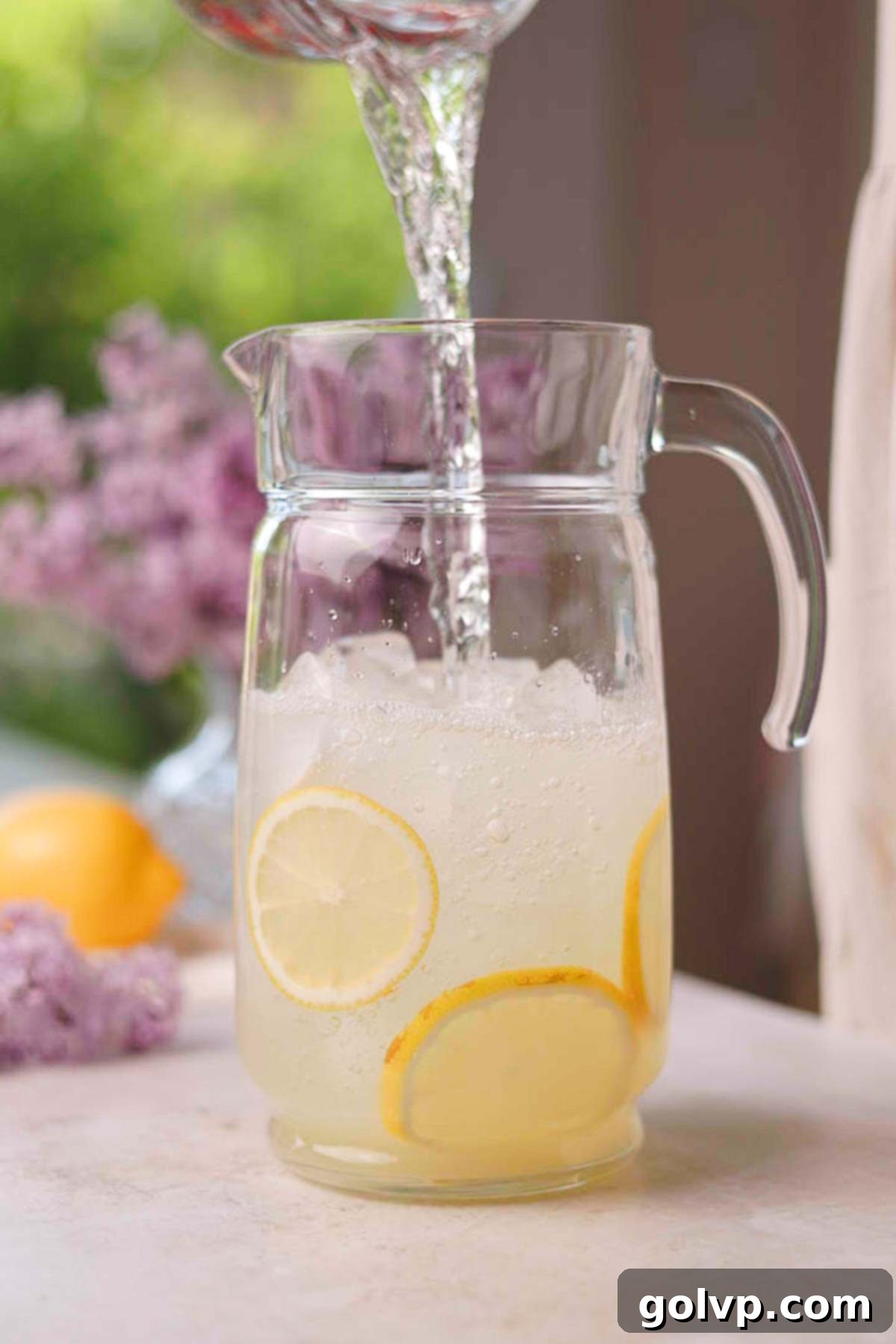
Step 2: Dilute with Water and Ice. Add 3 cups of fresh ice and 3 cups of cold water into the pitcher with the lemon juice. Stir briefly to combine. This forms the refreshing and zesty base of your lemonade, preparing it for the magical lilac infusion.
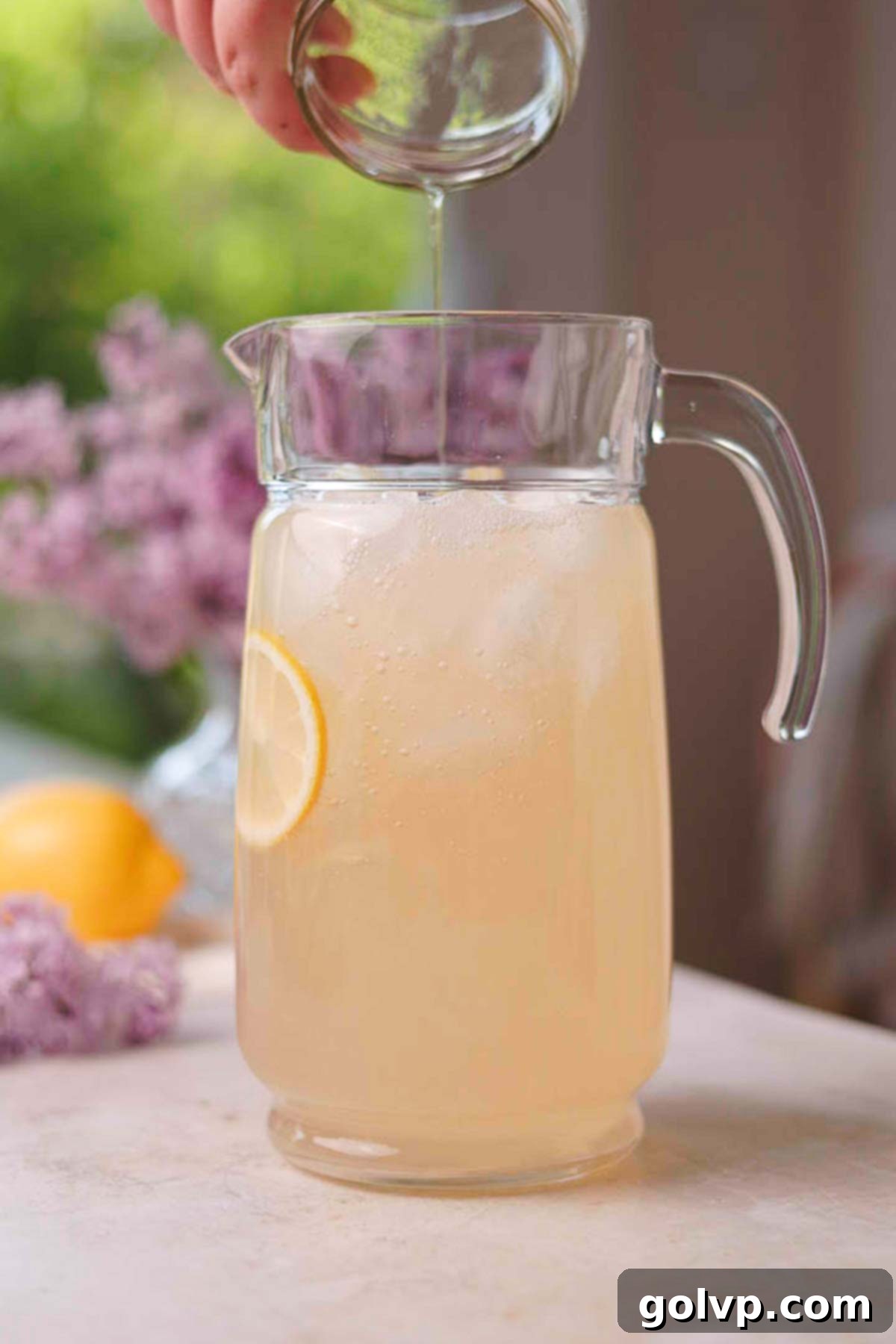
Step 3: Witness the Color Transformation. Now for the exciting part! Slowly pour the prepared lilac syrup into the lemonade pitcher. As the syrup mixes with the acidic lemon juice, observe the immediate and beautiful color change. The deep purple hue of the syrup will transform into a lovely peach, pink, or reddish-orange color. Stir gently to ensure the syrup is evenly distributed throughout the lemonade, and watch the magic unfold!
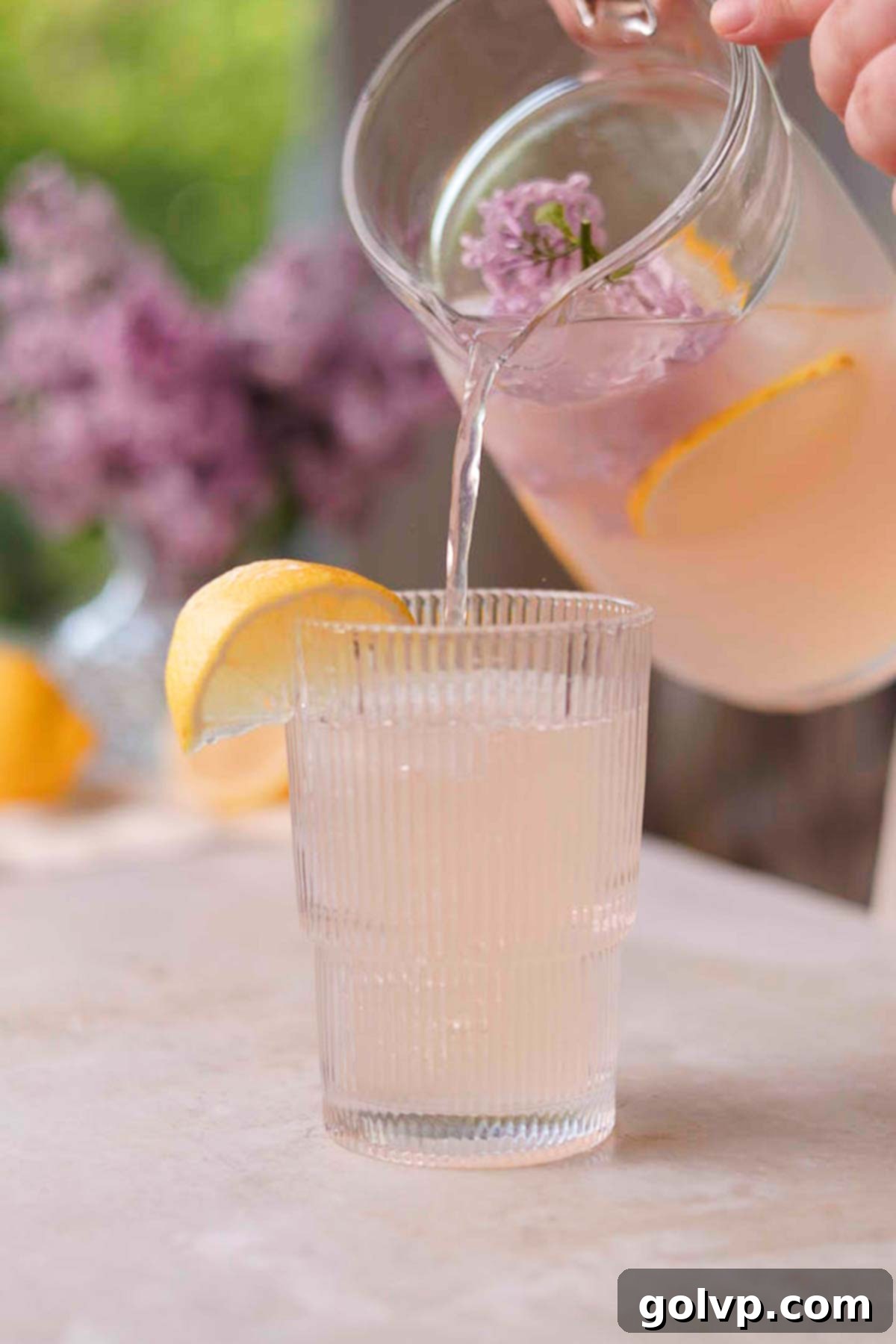
Step 4: Garnish and Serve. For an extra touch of elegance and freshness, optionally add some thin lemon slices and a carefully washed sprig of lilac blossoms directly into the pitcher or individual glasses. The visual appeal of these garnishes enhances the overall experience. Pour the vibrant lilac lemonade into glasses filled with ice and serve immediately. Enjoy this uniquely fragrant and refreshing homemade beverage!
🥤 Expert Tips for Perfect Lilac Lemonade
- Choose the Right Pitcher: As mentioned in the steps, always use a glass, ceramic, or food-grade plastic pitcher for your lemonade. Metal can react with the acidity of the lemon juice, imparting an unpleasant metallic flavor. This preserves the clean, fresh taste of your drink.
- Adjust Sweetness and Tartness to Taste: Lemons vary significantly in their acidity and sugar content, and personal preferences differ. After mixing, always taste your lemonade. If it’s too tart, add more sweetness. If it’s too sweet, a splash more lemon juice can balance it out. The beauty of homemade lemonade is customizing it!
- How to Add More Sweetness: If you find your lemonade needs more sugar, don’t just add granulated sugar directly, as it won’t dissolve properly in cold liquid. Instead, create a small batch of simple syrup by dissolving sugar in an equal amount of hot water (1:1 ratio) until clear. Let it cool, then stir it into your lemonade gradually until you reach your desired sweetness.
- For a Stronger Lilac Flavor: If you desire a more pronounced lilac taste, you can steep the lilac blossoms in the hot syrup for a longer period during step 3 of the syrup making. Let them steep for 30 minutes to an hour after removing from heat before straining. Be careful not to steep too long, as some floral flavors can become bitter.
- Serving Temperature is Key: Lilac lemonade is best served very cold. Ensure you have plenty of ice on hand, and consider chilling your pitcher and glasses before serving.
- Consider Carbonation: For a sparkling twist, you can replace a portion of the still water with sparkling water or club soda when assembling the lemonade. Add it just before serving to maintain the fizz.
🥄 Make Ahead & Storage Suggestions
This recipe is wonderfully adaptable for advance preparation, allowing you to enjoy fresh lemonade with minimal effort.
Lilac Syrup: The lilac simple syrup is incredibly stable and can be made well in advance. Store it in an airtight glass jar or container in the refrigerator for up to 1-2 weeks. This makes it perfect for having on hand whenever a craving for floral lemonade strikes, or for quick assembly when entertaining. The flavors will deepen slightly over time.
Assembled Lilac Lemonade: Once the lemonade is fully mixed, it is best enjoyed on the day it’s made for the freshest taste and most vibrant flavor. However, you can store any leftovers in an airtight pitcher or container in the refrigerator for 1-2 days. Be aware that the color may subtly change or fade slightly over prolonged storage, and the flavors might mellow. If you’re serving it later, a quick stir will re-distribute any settled particles. It’s not recommended to store it for longer than two days as the fresh lemon flavor will diminish.
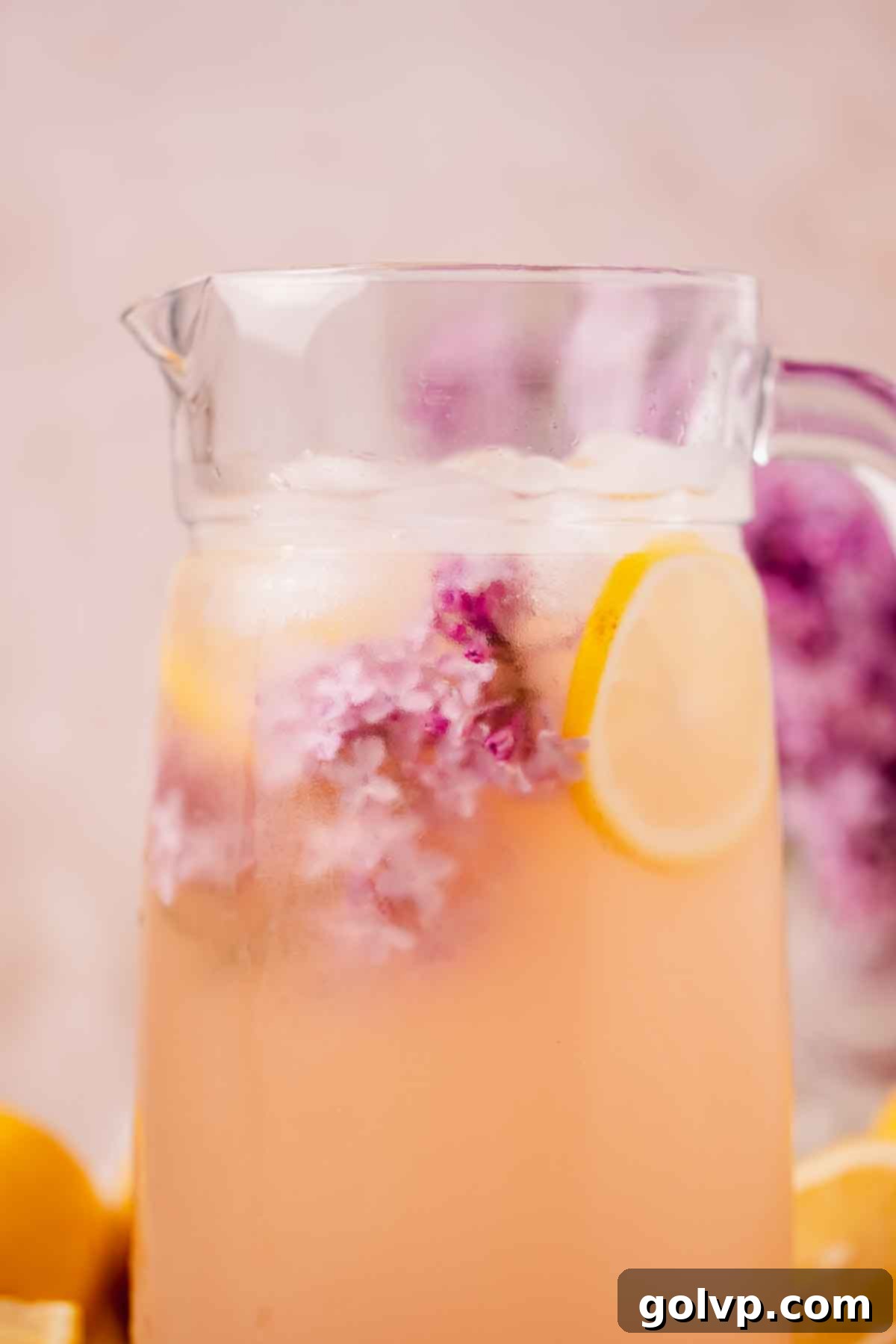
❔ What Do Lilacs Taste Like?
Lilacs are truly unique in the culinary world. The blossoms are indeed edible and possess a flavor profile that is remarkably similar to their enchanting scent: a delicate, sweet, and distinctly floral taste. This makes them a perfect ingredient for infusing syrups, desserts, and, of course, refreshing drinks like this lemonade.
It’s important to note that different varieties of lilacs may have subtle differences in their flavor and fragrance. Just as apples have various tasting notes, so too do lilacs. Therefore, when choosing lilacs for culinary use, it’s always best to select a variety whose scent is particularly pleasing to you, as this will generally translate into the most desirable flavor.
I personally find myself utterly captivated by the delicate floral flavor of lilacs, and I often lament how fleeting lilac season is! Their essence pairs exceptionally well with bright, zesty lemon. This synergy is so profound that my lilac lemon cake has become my most frequently requested dessert whenever the lilacs are in full bloom. Each year, my parents generously supply me with beautiful bouquets of lilacs from their abundant lilac tree, ensuring I can continue to experiment with and enjoy this wonderful ingredient.
For those who might be hesitant about using floral flavors in cooking due to past experiences with strong, sometimes “soapy” notes (as can sometimes occur with lavender, for example), lilacs offer a refreshing alternative. Their flavor is much more subtle, gentler, and inherently sweeter, making them a fantastic entry point into the world of edible flowers.
✔️ Where to Safely Source Lilacs for Cooking
Sourcing edible lilacs requires a bit of care to ensure they are safe for consumption. Here are the best ways to find them:
Your Own Garden or a Friend’s/Neighbor’s: The absolute best option is to use lilacs from your own garden or from someone you know who doesn’t use pesticides or herbicides. If you’re eyeing a neighbor’s beautiful lilac bush, simply ask if you could have a few sprigs! Most people are happy to share. This ensures you know exactly how the flowers have been grown and treated.
Grow Your Own: If you love lilacs, consider planting them! They are relatively low-maintenance and can grow as bushes, shrubs, or even small trees, providing a yearly bounty for your culinary adventures.
Farmers’ Markets: During lilac season, some local farmers’ markets may offer edible flowers. Always ask the vendor specifically if the lilacs have been grown without pesticides and are intended for consumption.
Floral Shops: If purchasing from a floral shop, it’s essential to be very specific with your questions. You *must* ask the florist if the lilacs have been treated with any floral preservatives, pesticides, or other chemicals that would make them inedible. Many commercially grown flowers are not intended for consumption, so this step is critical.
Avoid Wild Lilacs in Certain Areas: It’s generally best to avoid sourcing lilac blossoms for eating from the edges of busy roads, industrial areas, or public parks where chemical treatments or high levels of pollutants (like vehicle exhaust and dust) are likely. These flowers can absorb harmful substances, rendering them unsuitable for food preparation. Always choose flowers from clean, untainted environments.
❔ Are Lilacs pH Sensitive? The Science Behind the Color Change
Yes, lilacs are indeed pH sensitive, and this fascinating characteristic is precisely what makes our lilac lemonade so visually captivating! The science behind this magical color transformation lies in natural pigments called anthocyanins.
Anthocyanins are plant pigments responsible for the red, purple, and blue colors found in many fruits, vegetables, and flowers, including purple lilacs. These pigments are natural pH indicators, meaning their color changes depending on the acidity or alkalinity (pH level) of their environment.
When you create the lilac simple syrup, the anthocyanins extracted from the purple blossoms give the syrup a beautiful, rich purple hue. However, when this purple lilac syrup is introduced into the highly acidic environment of lemon juice (which has a low pH), the anthocyanins react. This reaction causes them to transform, resulting in the lemonade shifting from purple to a lovely reddish-pink or peach color.
While I haven’t specifically tested how lilac anthocyanins would react in a basic (alkaline) environment, theoretically, they would likely turn a more pronounced blue or even green, similar to how other anthocyanin-rich ingredients like red cabbage or butterfly pea flower tea behave.
It’s important to note that this captivating color-changing effect will not work with white lilacs. White lilac varieties lack the anthocyanin pigments necessary for this reaction, so while they can still be used to create a fragrant syrup, the lemonade will remain a traditional cloudy yellow color rather than transforming.
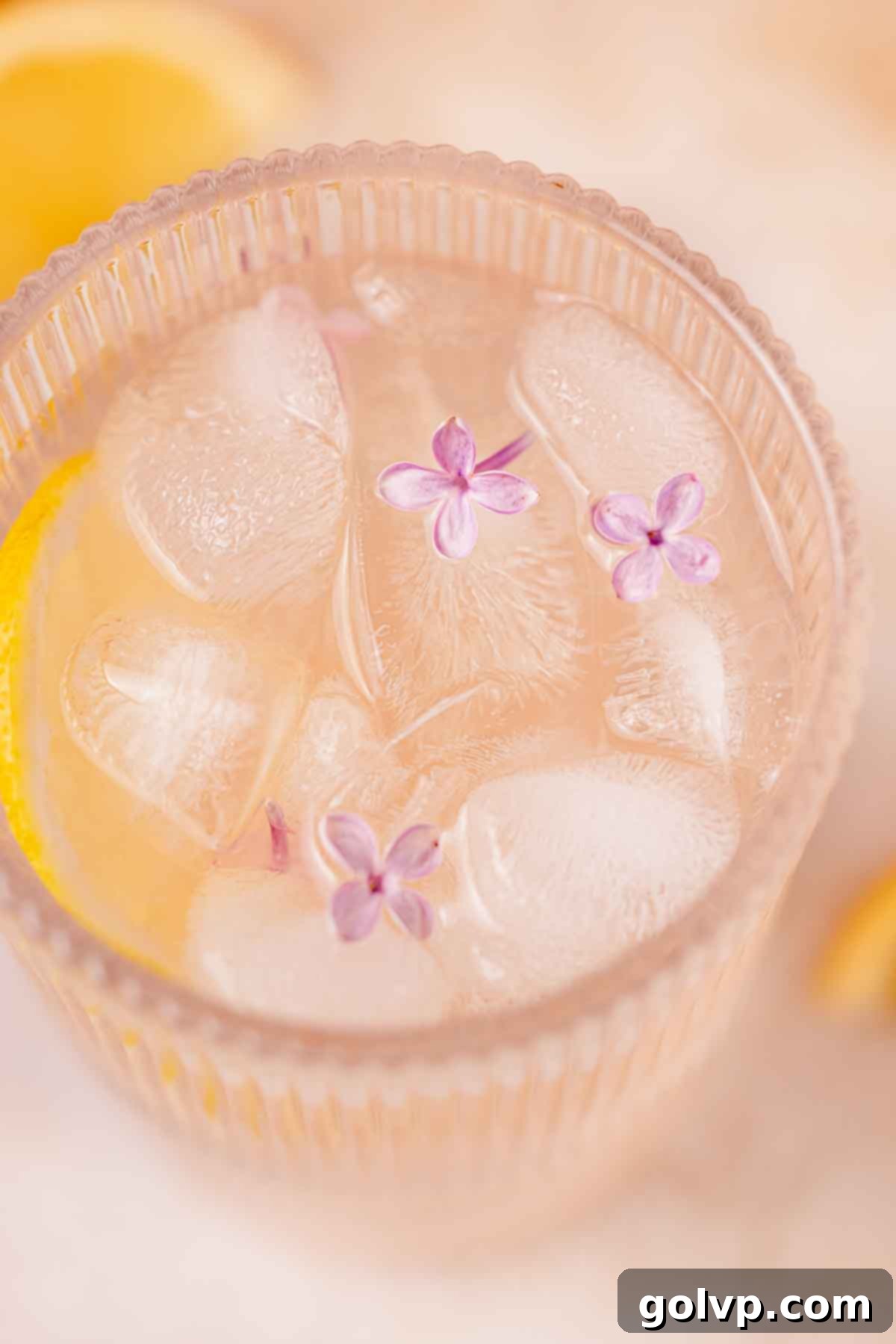
📖 Recipe FAQs – All Your Lilac Lemonade Questions Answered
The best substitute for homemade lilac syrup is elderflower syrup! It offers a very similar delicate, sweet, and floral flavor profile that pairs beautifully with lemon. You can often find store-bought elderflower syrup, which makes for a convenient alternative. Alternatively, you could try lavender syrup for a different floral note, though use sparingly as it can be stronger.
You will need approximately 4-6 large lilac blossom clusters, or about 2 cups of individual petals once they’ve been plucked and packed into a measuring cup. The recipe is quite forgiving, so a little less or a little more won’t significantly impact the outcome, but aim for a full 2 cups for the best flavor infusion.
The safest sources for edible lilacs are your own garden, or those of friends and neighbors who confirm they don’t use pesticides or other chemicals on their plants. Ensure the lilacs are not growing near busy roads or industrial areas to avoid pollution. If buying from a floral shop, always ask the florist specifically if the flowers are untreated and safe for consumption, as many commercial cut flowers are not.
Yes, all common varieties of lilac flowers are edible. They are prized for their delicate floral flavor and aroma, which is wonderfully captured in infusions like simple syrups. My favorite way to use them is to create a fragrant syrup, perfect for drinks like this lilac lemonade, or in baked goods such as my popular lilac cake.
Absolutely! This homemade lilac simple syrup is incredibly versatile. You can substitute it for regular simple syrup in virtually any cocktail or non-alcoholic drink recipe to add a unique floral twist. Try it in iced tea, sparkling water, gin and tonics, or even drizzled over pancakes or fresh fruit for a gourmet touch.
Purple lilacs contain natural pigments called anthocyanins. These anthocyanins act as natural pH indicators. When the lilac syrup, which typically has a more neutral pH, is poured into the highly acidic lemon juice, the change in pH causes the anthocyanins to react and transform their color. This is why the lemonade magically shifts from a purplish hue to a beautiful peach or reddish-orange.
While you can certainly use white lilacs to make a fragrant syrup, your lemonade will not exhibit the captivating color-changing effect. This is because white lilac varieties do not contain the anthocyanin pigments responsible for the pH-sensitive color shift found in purple lilacs. However, the lemonade will still taste delicious and retain a lovely floral aroma!
🍋 More Refreshing & Floral Recipes to Explore
If you loved the unique blend of floral and citrus in this lilac lemonade, you’ll be thrilled to discover more delightful recipes that capture these enchanting flavors. From elegant cakes to creamy desserts and other vibrant beverages, here are some related recipes to inspire your culinary adventures:
- Lilac Cake with Lemon: A Zesty Floral Masterpiece
- Creamy Lemon Tiramisu with Homemade Lemon Curd
- Vibrant Blueberry Lemon Cake with Curd Filling
- Zesty Lemon Curd Crinkle Cookies
Did you make this refreshing lilac lemonade recipe? I would absolutely love for you to rate this recipe and share your thoughts in the comments section below! Your feedback is invaluable. Don’t forget to share your beautiful creations on Instagram and tag me @flouringkitchen so I can see your magical color-changing drinks. For more delicious recipes and culinary inspiration, follow me on Pinterest to save your favorite ideas!
📖 Recipe Card: Color Changing Lilac Lemonade
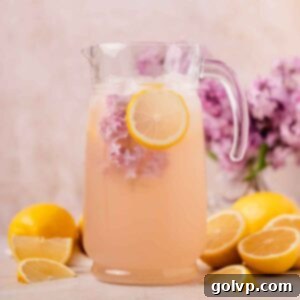
Lilac Lemonade
Mary
Pin Recipe
Shop Ingredients
Equipment
-
2 litre glass pitcher 8 cups
Ingredients
Lilac Syrup
- 2 cups lilac blossoms packed
- 1 cup granulated sugar
- 1 cup water
Lemonade
- 3 lemons ¾ cup juiced
- 3 cups ice
- 3 cups water
- lemon slices
- lilac blossom sprig
Shop Ingredients on Jupiter
Instructions
Lilac Syrup
-
Pluck the lilac flowers off of the lilac stems into a bowl. Add water to cover, let sit for 10 minutes, and rinse well to remove any dirt and bugs. Drain the water off. Measure 2 cups of lilac blossoms, packed into the measuring cup. You can add slightly more or less, depending on how much you have.2 cups lilac blossoms
-
Place picked and washed lilac flowers into a medium saucepan. Add sugar and 1 cup of water. Bring to a boil and simmer for 1 minute.1 cup granulated sugar, 1 cup water
-
Turn off the heat and let it cool to room temperature in the saucepan.
-
Strain the syrup into a jar or container, and squeeze out any syrup left over in the petals. Discard the flowers.
Lemonade
-
Squeeze the lemons and pour the juice into a large non-metal pitcher for the lemonade.3 lemons
-
Add 3 cups of ice and 3 cups of water into the pitcher.3 cups ice, 3 cups water
-
Pour the lilac syrup into the lemonade and stir. Watch the color of the lemonade change to a peach color!
-
Optionally, add some lemon slices and a washed sprig of lilacs into the lemonade. Pour and serve!lemon slices, lilac blossom sprig
Video
Notes
Storage: The lemonade can keep in the fridge for 1-2 days. I recommend enjoying it the day it’s made because it will taste the most fresh.
Lemonade Tips:
- Don’t use a metal pitcher to avoid a metallic aftertaste in your lemonade. Use a glass, ceramic, or coated pitcher.
- Taste your lemonade and add more sweetness or lemon if you need to! Lemons vary in flavor and acidity.
- If you need to make it sweeter, dissolve sugar in hot water in a 1:1 ratio and stir. Add to the lemonade to taste.
Nutrition
